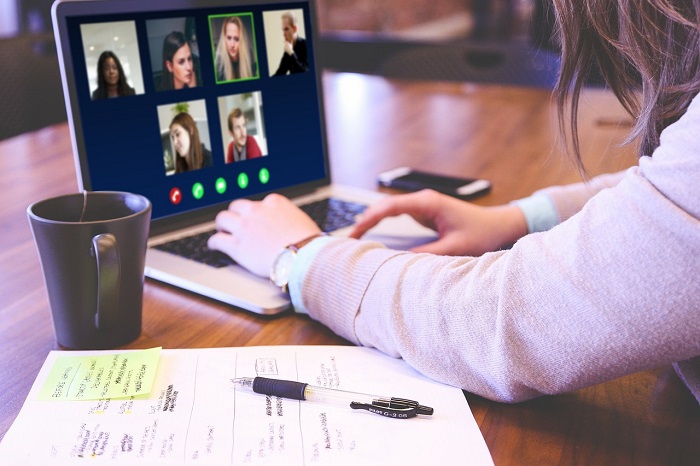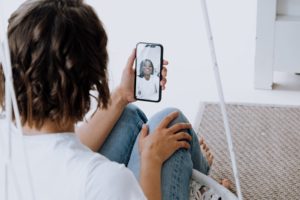- MN ABE Connect
- Archive
- Re-Imagining Instruction Part 2: Flipping the Classroom
 January 11, 2021
January 11, 2021
Re-Imagining Instruction Part 2: Flipping the Classroom
Joey LehrmanJoey Lehrman, with Delgado Community College and ISTE’s SkillRise Initiative, was also the keynote speaker at the 2020 Math Institute presented by ATLAS.
What does “flipping the classroom” look like?
Start by rethinking the role of a lecture
Technology can help us to be more strategic and effective with how we use our scarce time together with students. While we have known for several decades that lectures are ineffective, many instructors still use class time to explain concepts. Instead, direct students to those explanations before and after class. After all, the internet is filled with great explanations from excellent content creators (e.g., Crash Course).
 Simply put, live class time should only be used for the activities that can’t be done alone. Because of advances in technology, conceptual explanations can happen anytime and anywhere. That shift can enable us to use our scarce time together for everything else: for social connection, to ask interesting questions, to pair students for peer learning, for tutoring, to build trusting relationships and a sense of community, to differentiate instruction around the unique learning needs of each student, and to practice deeper, more conceptual applications where the learning community can collaboratively explore open-ended problems.
Simply put, live class time should only be used for the activities that can’t be done alone. Because of advances in technology, conceptual explanations can happen anytime and anywhere. That shift can enable us to use our scarce time together for everything else: for social connection, to ask interesting questions, to pair students for peer learning, for tutoring, to build trusting relationships and a sense of community, to differentiate instruction around the unique learning needs of each student, and to practice deeper, more conceptual applications where the learning community can collaboratively explore open-ended problems.
The Modern Classroom Project provides a promising model for how to rethink our time together in a way that is student-centered as learners are empowered to take ownership over their learning path. Removing the lecture from live class time (online or in-person) may be the single most important shift we can make.
The more time educators spend with their students in small groups or individually, the more likely they are to:
1. Differentiate
2. Be data-driven
3. Support social-emotional learningEducators need instructional models that free them up to provide truly personalized support.
— Kareem Farah (@Kareemfarah23) November 24, 2020
Note that lecturing and explanations can still be a helpful and important part of the learning process, especially for adult learners that enter classrooms expecting lectures and looking for additional social-emotional support around the learning process. The key here is re-thinking how and when the lecture happens; technology enables us to transform how we spend our time together, so live classes can be used for the learning tasks that can’t be done alone.
Once you reclaim class time, it can then be helpful to “stretch” your practice by considering moving the lecture from the first task to later in the learning process.
Where to get started
Remember that when trying new things, progress can be slow and filled with mistakes. A good guiding value is that our “north star” is aspirational: it’s a vision we will likely work towards continuously over time without ever really perfecting the practice. So be kind and patient with yourself and your students as you explore the transition to blended, mastery-based learning.
In that spirit, it can be helpful to start small and then continue to reach for a new “stretch.” The following is a hierarchy of ways you can begin to rethink your adult education classroom:
 Stop lecturing. Text students a short 10-minute video to watch before or after class. Then, use instructional time, whether on Zoom or on-campus, to practice problems, ask questions, and have students share their thinking. This strategy has the added benefit of being mobile-friendly, as we’ve learned a large portion of adult learners only access online learning through mobile devices.
Stop lecturing. Text students a short 10-minute video to watch before or after class. Then, use instructional time, whether on Zoom or on-campus, to practice problems, ask questions, and have students share their thinking. This strategy has the added benefit of being mobile-friendly, as we’ve learned a large portion of adult learners only access online learning through mobile devices.
- Here’s a sample lesson plan that includes a model for what this pre-class activity can look like. Note here that the pre-class activity doesn’t need to be a lecture; it can be any video that inspires curiosity and lays the foundation for the live class activity.
- Develop a mastery-tracker, so students can track which standards they’ve mastered and where to focus their time. This helps students build metacognitive skills as they reflect on what they’ve learned and what to study next. It also helps adult learners build confidence as they can see and measure their own progress. Lastly, tracking mastery helps shift the control from a teacher-centered classroom as students realize that they can use technology, their instructor, and their peers to drive their own learning.
- Here’s a sample mastery tracker. (Note: You’ll need to make your own copy of it first in order to see it.) Try ticking a few boxes to see how it works. Then, imagine what’s possible if we can help students build the skills needed to track their own learning!
- As a stretch, start developing more meaningful formative and summative assessments that students can use to evaluate standards-mastery. Reporting features from standardized tests like TABE can be limited in how actionable the data is for students and instructors.
 Use time together for conversation. Ask students to share their thinking. Focus less on “right” and “wrong” and more time on different ways to visualize and solve open-ended problems. This can be done online (e.g., Zoom, Teams) and in-person. This is a shift I expect we will continue to see in K12, higher education, and corporate training programs (as evidenced here and here). This speaks to the power of social learning; we learn best from each other. It also furthers the importance of spending less time together on lectures. Remember that conceptual explanations can happen anytime. Strive to use live class time together for the things that cannot be done alone.
Use time together for conversation. Ask students to share their thinking. Focus less on “right” and “wrong” and more time on different ways to visualize and solve open-ended problems. This can be done online (e.g., Zoom, Teams) and in-person. This is a shift I expect we will continue to see in K12, higher education, and corporate training programs (as evidenced here and here). This speaks to the power of social learning; we learn best from each other. It also furthers the importance of spending less time together on lectures. Remember that conceptual explanations can happen anytime. Strive to use live class time together for the things that cannot be done alone.- Remain blended. Even as campuses start to re-open, all courses can continue to be delivered in distance and blended settings. This not only helps students continue building essential digital literacy skills but also ensures learning remains accessible and is not tied to a specific time and place.
As we navigate this new world of distance and blended learning, let’s strive to use this opportunity to rethink and evolve our practice. Learning can be student-centered and can happen anytime and anywhere. It’s unclear if any meaningful best practices yet exist in distance learning for adult students. So in an era of uncertainty, try something new, be ready to make mistakes, reflect, and connect with peers both locally and nationally to share what’s working so we can all learn from our collective experience.
Ultimately, these shifts can hopefully help to nurture independent learning where students are setting their own learning goals, monitoring progress, and using time with their teacher and peers to practice difficult concepts and engage as lifelong learners.
- Part 1 of this article explored shifting from dependent to independent learning and using technology to facilitate conversation.
- Did you miss any of the September 2020 ABE Math Institute where Joey presented?
View the recorded sessions from the conference >>
Joey Lehrman is the Program Effectiveness Coordinator for the Adult Education Program at Delgado Community College and Project Manager for ISTE’s’ SkillRise, where he brings over 10 years of experience as a classroom teacher and administrator in adult education and career pathway programming. Find Joey on Twitter and LinkedIn and at teachjoey.com.

Newsletter Signup
Get MN ABE Connect—the official source for ABE events, activities, and resources!
Sign UpArticle Categories
- ABE Foundations/Staff Onboarding
- ACES/Transitions
- Adult Career Pathways
- Assessment
- CCR Standards
- Citizenship
- COVID-19
- Cultural Competency
- Digital Literacy/Northstar
- Disabilities
- Distance Learning/Education
- ELA
- Equity/Inclusion
- ESL
- HSE/Adult Diploma
- Listening
- Math/Numeracy
- Mental Health
- Minnesota ABE
- One-Room Schoolhouse/Multilevel
- Professional Development
- Program Management
- Reading
- Remote Instruction
- Science
- Social Studies
- Speaking/Conversation
- Support Services
- Teaching Strategies
- Technology
- Uncategorized
- Volunteers/Tutors
- Writing